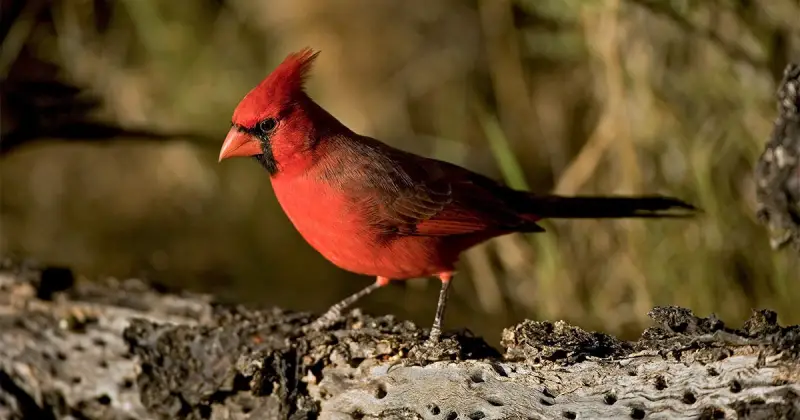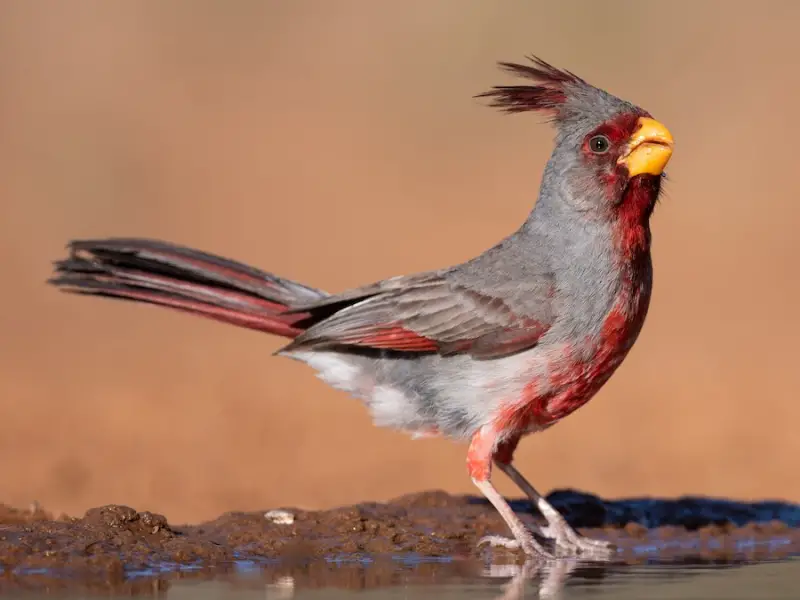I still remember the first time I saw a flash of crimson dart across the mesquite trees in southern Arizona. The morning sun was barely peeking over the horizon, and the air was cool enough to carry the clear, whistling notes of a bird I couldn’t yet see. I stood still, binoculars in hand, scanning the branches until the singer revealed himself—a male Northern Cardinal, his feathers glowing against the desert green like a living ember. It was one of those moments when time slows down, and all you can do is watch in awe.
A few days later, while hiking along a dusty trail lined with prickly pear cactus, I caught sight of another bird—similar in shape, but cloaked in soft gray with splashes of red on the face and wings. Its thick, yellowish bill and quiet whistles told me this was no Northern Cardinal but its desert cousin, the Pyrrhuloxia. That was the day I realized Arizona has not just one, but two species of cardinals, each with its own beauty and personality.
Since then, I’ve spent countless mornings exploring riparian corridors and desert scrublands, watching these birds go about their lives—singing from high perches, chasing away rivals, and hopping through the underbrush in search of seeds. In this guide, I’ll share everything I’ve learned about the two types of cardinals in Arizona, from how to tell them apart to where and when you’re most likely to see them. Whether you’re a seasoned birder or just someone who appreciates a burst of color in the desert, I hope my encounters will inspire you to go out and meet these remarkable birds for yourself.
Northern Cardinal in Arizona

Physical Characteristics and Identification
The Northern Cardinal (Cardinalis cardinalis) is the most instantly recognizable of Arizona’s cardinal species. The male is particularly eye-catching, with his brilliant crimson feathers that seem to glow against the backdrop of desert vegetation or leafy riparian corridors. His striking red crest rises proudly above the head, and his face is accented with a bold black mask that extends from the beak around the throat. The bill is thick, conical, and bright orange-red, perfectly adapted for cracking seeds. In contrast, the female is more subdued in coloration, with warm brown plumage tinged with reddish hues on the wings, tail, and crest. She also sports the same orange bill and subtle black facial markings.
Adult Northern Cardinals typically measure between 8.3 and 9.1 inches (21–23 cm) in length and have a wingspan of about 9.8 to 12.2 inches (25–31 cm). Their sturdy build and medium-long tail make them appear slightly larger than many backyard songbirds. Juveniles resemble the female in coloration but have a darker bill that gradually turns orange as they mature. The combination of size, crest, and vibrant color makes the Northern Cardinal nearly impossible to mistake for any other species in Arizona, except for the Pyrrhuloxia, which has a more muted appearance.
Behavior and Vocalizations
Northern Cardinals are well known for their strong territorial instincts, particularly during the breeding season. Males are often seen perched in exposed areas, singing loudly to establish dominance and ward off rivals. Their song is a rich series of clear whistles, often described as “cheer, cheer, cheer” or “birdie, birdie, birdie.” Females also sing, sometimes in response to the male’s song, which is unusual among North American songbirds. This vocal communication plays an important role in maintaining pair bonds and coordinating nesting duties.
These birds are primarily ground foragers, hopping through undergrowth and leaf litter in search of seeds, berries, and insects. In winter, they often visit backyard feeders, where they are particularly fond of sunflower seeds. Northern Cardinals are generally monogamous and may mate for life. Pairs are known for their courtship feeding behavior, where the male offers food to the female, reinforcing their bond.
Habitat and Distribution in Arizona
In Arizona, Northern Cardinals are most often found in the southeastern portion of the state, particularly in areas with dense vegetation. They prefer habitats such as mesquite thickets, riparian corridors, suburban gardens, and woodland edges. While they are adaptable, they require at least some cover for nesting and protection from predators. You are most likely to spot them along river valleys and washes where moisture supports lush plant growth, creating ideal conditions for feeding and nesting.
Their year-round presence means that birdwatchers in Arizona can enjoy sightings in every season. In winter, the male’s red plumage stands out vividly against the muted tones of the desert, while in spring, their energetic singing signals the start of breeding season. These birds are non-migratory, so once a pair establishes a territory, they are likely to remain in the same general area for years.
Pyrrhuloxia in Arizona

Physical Characteristics and Identification
The Pyrrhuloxia (Cardinalis sinuatus) is sometimes called the “desert cardinal” due to its preference for arid and semi-arid environments. While related to the Northern Cardinal, its appearance is quite different and more understated. Males have a distinctive blend of gray plumage with subtle reddish accents on the face, crest, wings, and tail. The face sports a bold red mask around the bill, which contrasts with the surrounding gray feathers. Females are predominantly grayish-brown with even fainter red highlights, making them more challenging to identify at a distance.
One of the most notable features of the Pyrrhuloxia is its bill. Unlike the Northern Cardinal’s bright orange cone-shaped bill, the Pyrrhuloxia’s bill is shorter, thicker, and pale yellow, resembling the shape of a parrot’s beak. This adaptation is particularly suited to cracking open the tough seeds of desert plants. Adults measure about 8.3 inches (21 cm) in length with a similar wingspan to the Northern Cardinal, but their overall slimmer appearance and more muted coloration make them look less robust.
Behavior and Vocalizations
The Pyrrhuloxia shares many behavioral traits with the Northern Cardinal but has some differences related to its desert lifestyle. These birds are agile foragers, often seen moving through thorny shrubs or perching on cactus stems while searching for seeds and insects. They are highly adapted to surviving in hot, dry conditions, obtaining much of their water from the food they consume. Their diet includes mesquite seeds, cactus fruits, and various insects during the breeding season.
The Pyrrhuloxia’s song is a series of sweet, clear whistles that can sound remarkably similar to that of the Northern Cardinal, though often softer and less powerful. Males sing frequently during the breeding season to defend territory and attract mates, while females may sing more quietly in response. Courtship feeding is also common in this species, and pairs tend to stay together year-round.
Habitat and Distribution in Arizona
In Arizona, the Pyrrhuloxia is found mainly in southern and central parts of the state, particularly in desert scrub, mesquite bosques, and areas with scattered cacti. They thrive in regions where water is scarce, making them a common sight in habitats that might be too dry for the Northern Cardinal. However, in some areas, the ranges of the two species overlap, and careful observation is needed to distinguish them.
These birds are most active in the cooler hours of early morning and late afternoon, retreating to shady cover during the hottest parts of the day. They are permanent residents in their territories, and their presence adds a splash of color to Arizona’s desert landscapes throughout the year. While their plumage may not be as vibrant as that of the Northern Cardinal, their adaptability and resilience make them equally captivating.
Telling Northern Cardinals and Pyrrhuloxia Apart
Key Identification Differences
At first glance, the Northern Cardinal and Pyrrhuloxia might seem similar, especially to those new to birdwatching. However, once you know the differences, identifying them becomes much easier. The Northern Cardinal male’s all-over red plumage and black mask are unmistakable, while the Pyrrhuloxia male’s gray body with red highlights gives it a more subdued appearance. The bill color and shape are also major clues—bright orange and cone-shaped for the Northern Cardinal, pale yellow and parrot-shaped for the Pyrrhuloxia.
Females of both species are less vividly colored but still differ in tone. Female Northern Cardinals are warm brown with reddish tinges, while female Pyrrhuloxia are grayish with faint red accents. In mixed habitats where both species occur, paying attention to these subtle differences will help you make an accurate identification.
Seasonal Behavior and Breeding
Breeding Seasons in Arizona
Both the Northern Cardinal and Pyrrhuloxia begin breeding in spring, with courtship behaviors starting as early as February in the warmer parts of Arizona. Males stake out territories through song and displays, and once a pair bonds, they will search for suitable nesting sites. The Northern Cardinal typically nests in dense shrubs or small trees, often no more than a few feet above the ground. Pyrrhuloxia, adapted to desert conditions, often choose thorny bushes or cactus plants for extra protection from predators.
The female builds the nest from twigs, grasses, and rootlets, lining it with softer materials such as animal hair or plant fibers. Both species lay between two and four eggs per clutch, which are incubated primarily by the female. The male assists by bringing food to the nest, especially once the chicks hatch. Fledging usually occurs within 10 to 12 days, though the young remain dependent on the parents for several more weeks.
Winter Adaptations and Territory Maintenance
While both Northern Cardinals and Pyrrhuloxia are year-round residents of Arizona, their behavior shifts slightly during the cooler months. Northern Cardinals tend to expand their feeding ranges in winter, visiting more open areas and backyard feeders when natural food becomes scarce. Their vibrant plumage contrasts beautifully with the muted winter desert tones, making them easy to spot. Males may still sing sporadically to maintain territory boundaries, but vocal activity is less intense than during spring.
Pyrrhuloxia are equally resilient, relying heavily on the desert’s seed supply during winter. Mesquite pods, dried cactus fruits, and seeds from native grasses sustain them through this period. They tend to move in loose flocks outside of the breeding season, often joining other desert species such as sparrows or finches to forage. This flocking behavior increases their chances of finding food and provides extra vigilance against predators.
Seasonal Movements and Overlap
Although neither species migrates long distances, local movements do occur depending on food availability and weather conditions. In years of drought, Pyrrhuloxia may be more commonly seen near irrigated areas or river corridors where food and water are more abundant. Northern Cardinals may also shift closer to urban gardens and parks during dry spells, where bird feeders and ornamental plantings provide sustenance.
The two species sometimes overlap in riparian and semi-arid zones, particularly in southern Arizona. When this happens, careful observation is needed to separate them, especially when females or juveniles are involved. Subtle cues like bill shape, body coloration, and vocal differences become crucial for accurate identification.
Feeding Ecology and Diet
Northern Cardinal Feeding Habits
Northern Cardinals are opportunistic feeders with a diet that changes seasonally. Seeds form the bulk of their diet for much of the year, with sunflower seeds, millet, and various native plant seeds being common choices. They also consume a wide variety of fruits and berries, including hackberry, mulberry, and elderberry, which provide essential vitamins and hydration.
Insects become an important dietary component during the breeding season, as they are a rich source of protein needed for chick development. Cardinals hunt for beetles, caterpillars, grasshoppers, and other small invertebrates, often gleaning them from foliage or the ground. Their strong beaks allow them to crack tough seeds with ease, but they are also adept at picking soft fruits and catching slow-moving insects.
Pyrrhuloxia Feeding Habits
The Pyrrhuloxia’s diet reflects its adaptation to desert life. It feeds heavily on seeds from mesquite, saltbush, and other hardy desert plants. The parrot-like beak is perfectly suited for breaking open hard-coated seeds that many other birds cannot access. During the spring and summer months, Pyrrhuloxia also feed on insects such as grasshoppers, ants, and beetles, supplementing their protein intake for breeding.
One of their favorite food sources is the fruit of the prickly pear cactus, which provides both nutrients and moisture. They skillfully remove the outer skin to access the sweet pulp inside, avoiding the cactus spines. This adaptation allows them to thrive in regions where water is scarce. Like Northern Cardinals, they will occasionally visit backyard feeders, particularly those stocked with safflower or black oil sunflower seeds.
Predators and Threats
Natural Predators
Both Northern Cardinals and Pyrrhuloxia face similar natural predators. Birds of prey such as Cooper’s Hawks and Sharp-shinned Hawks are the most common avian threats, often targeting cardinals during open flights between cover. Snakes, including gopher snakes and coachwhips, pose a risk to eggs and nestlings. Mammalian predators such as raccoons, domestic cats, and squirrels also prey on eggs and young birds.
Human-Related Threats
Urbanization and habitat loss are significant concerns for both species. Clearing dense shrubs and riparian vegetation for development reduces available nesting sites and food sources. Window collisions in urban areas account for many accidental deaths, as cardinals are prone to flying into reflective glass when startled. Pesticide use can also indirectly harm these birds by reducing insect populations, an important food source during breeding.
Domestic cats present a particular danger, as both species forage on or near the ground. In suburban settings, free-roaming cats can significantly impact local cardinal populations, especially fledglings learning to fly.
Conservation Status
Current Population Trends
The Northern Cardinal is listed as a species of Least Concern by the IUCN, and its population in Arizona remains stable. Its adaptability to suburban environments has helped it maintain healthy numbers, and many individuals benefit from backyard feeders and ornamental plantings.
The Pyrrhuloxia is also classified as Least Concern, though its population is more closely tied to the health of desert habitats. Prolonged drought, invasive plant species, and overgrazing can alter the desert plant communities on which it depends. While the species remains relatively common, ongoing habitat conservation is essential to ensure its continued success.
Conservation Efforts in Arizona
Local conservation organizations and birding groups in Arizona work to preserve riparian corridors and desert ecosystems that benefit both species. Planting native vegetation, reducing pesticide use, and promoting wildlife-friendly landscaping in urban and suburban areas can all support healthy populations. Educational programs also raise awareness about keeping cats indoors and reducing window collision risks.
Birdwatching Tips for Cardinals in Arizona
Best Times and Places to See Them
For Northern Cardinals, the best sightings often occur in southeastern Arizona, especially along riparian zones like the San Pedro River, or in lush suburban neighborhoods with mature trees and dense shrubbery. Early mornings are prime birdwatching hours, when the males are singing and both sexes are actively foraging.
For Pyrrhuloxia, head to southern and central Arizona’s desert scrub habitats, particularly areas with abundant mesquite or cactus. The cooler hours after sunrise and before sunset offer the best opportunities for observing their natural behaviors. Carrying a pair of binoculars will help in spotting subtle color differences that distinguish them from Northern Cardinals.
FAQs About Cardinals in Arizona
What are the two types of cardinals found in Arizona?
Arizona is home to the Northern Cardinal and the Pyrrhuloxia. The Northern Cardinal is known for its vibrant red coloration in males and warm brown tones in females, while the Pyrrhuloxia has gray plumage with red highlights and a distinctive yellow, parrot-like bill.
Do both species live in the same parts of Arizona?
Their ranges overlap in some areas, particularly in southern Arizona, but Northern Cardinals are more common in riparian and suburban habitats, while Pyrrhuloxia favor arid desert scrub and mesquite-dominated landscapes.
How can I tell a Northern Cardinal from a Pyrrhuloxia?
The easiest way to distinguish them is by looking at bill shape and color. Northern Cardinals have a bright orange-red, cone-shaped bill, while Pyrrhuloxia have a shorter, thicker, pale yellow bill. Plumage patterns also differ, with cardinals being more uniformly red in males and browner in females.
Are cardinals in Arizona migratory?
No, both species are year-round residents. They may move locally in search of food and water, but they do not undertake long migrations.
What do cardinals eat in Arizona?
Both species feed on seeds, fruits, and insects. Northern Cardinals often consume berries and sunflower seeds, while Pyrrhuloxia specialize in desert plant seeds and cactus fruits. Insects are especially important during the breeding season.
Can I attract cardinals to my backyard in Arizona?
Yes. Planting native shrubs and trees, offering sunflower or safflower seeds, and providing a reliable water source can draw both Northern Cardinals and Pyrrhuloxia to your yard. Avoid using pesticides to ensure a healthy insect population for them to feed on.
Are cardinals protected in Arizona?
Yes. Both species are protected under the Migratory Bird Treaty Act, which prohibits the capture, killing, or possession of these birds, their eggs, or nests without proper permits.






